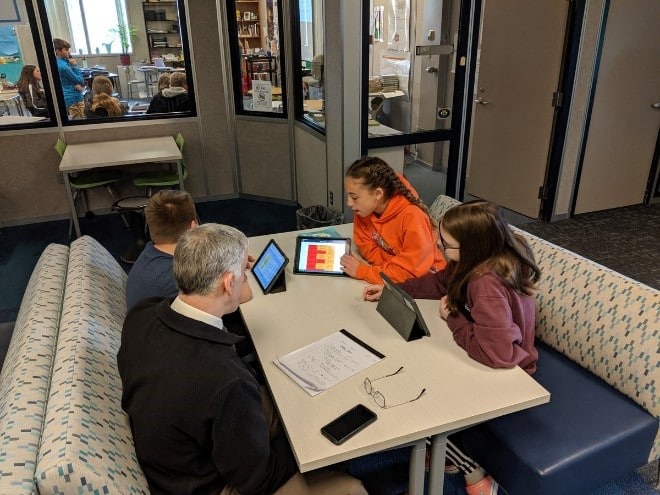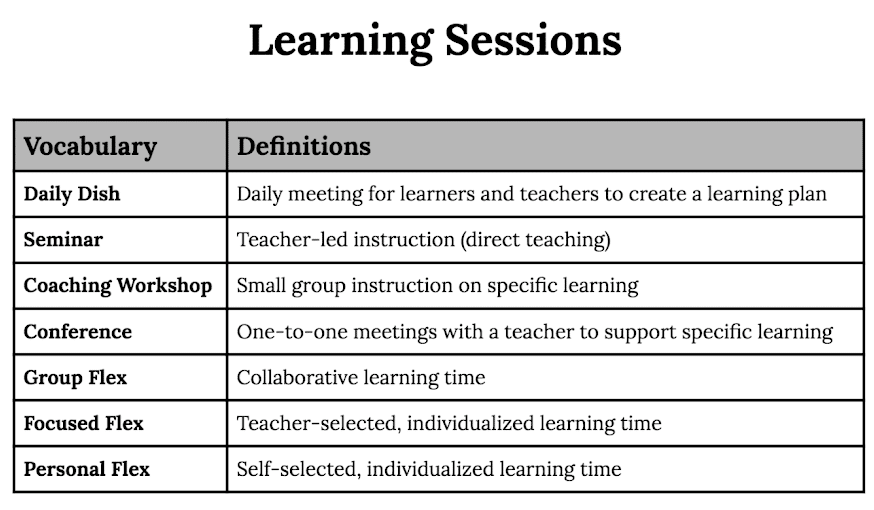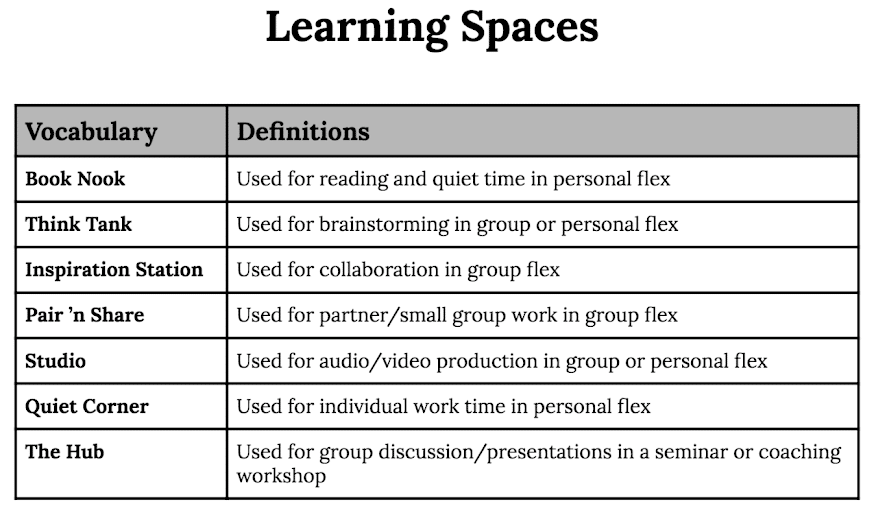Interstellar Time at Boeckman Middle School
CompetencyWorks Blog
This is the fourth post in a series about the Farmington Area Public Schools in Minnesota. Links to the other posts are provided at the end of this article.
 Farmington’s emphasis on teacher agency means that competency-based education is evolving in many different forms across the district. Boeckman Middle School has developed Interstellar Time, which brings a competency-based approach to selected subjects and grade levels.
Farmington’s emphasis on teacher agency means that competency-based education is evolving in many different forms across the district. Boeckman Middle School has developed Interstellar Time, which brings a competency-based approach to selected subjects and grade levels.
During the 2018-19 school year, Interstellar Time served 90 7th-graders during a four-and-a-half hour period every other day focused on language arts, math, and social studies. During the 2019–20 school year, the initiative will expand to include 8th-graders in language arts, social studies, and art classes. These academic subjects reflect the teachers who wanted to participate. The expansion to 8th grade will mean that students in the 7th-grade Interstellar cohort will be able to continue their involvement in this approach to learning for a second year.
Boeckman Principal Megan Blazek explained, “Our mission is to provide an environment where learners become owners of their learning, informed problem solvers, and reflective goal setters.” The Interstellar Time website explains that the personalized learning innovation “allows learners to schedule time to work on their specific learning needs at any time, any place, any path, any pace. Our goal is to develop strong learners and leaders—learners who are able to think flexibly, critically, and creatively as well as communicate and collaborate with others.”
Every student has an iPad, and teachers build playlists of learning activities and assessments aligned to competencies that students need to demonstrate. These playlists are provided via the Schoology learning management system, and students’ progress on demonstrating evidence of competencies is tracked with an individualized Google sheet. Next year they will move away from the Google sheet and use Campus Learning, which is an add-on to Infinite Campus. Some learning activities are carried out on iPads, but others take place on paper or through group activities.
Each day of Interstellar time begins with an activity where students schedule their time for the day, based on their personal learning needs and progress. The scheduling is facilitated by FlexiSched, a Google Chrome extension. As shown in the “Learning Sessions” table below, students have many options about how to use their time—ranging from student-led individualized and group learning to teacher-led instruction such as seminars and coaching workshops. Teachers who want to designate the activities of selected students can schedule them for “focused flex” time, while many students select their own activities and schedule them under one of the other learning session categories.

 The Interstellar learning spaces are also varied, to facilitate these different types of activities. Boeckman took advantage of a local facilities grant to remove the walls of several classrooms and create a common space with rugs, open spaces, and various types and configurations of tables and chairs. Some of these can be seen in the accompanying photo. The common space is surrounded by classrooms with a more traditional layout that can accommodate a full class of students.
The Interstellar learning spaces are also varied, to facilitate these different types of activities. Boeckman took advantage of a local facilities grant to remove the walls of several classrooms and create a common space with rugs, open spaces, and various types and configurations of tables and chairs. Some of these can be seen in the accompanying photo. The common space is surrounded by classrooms with a more traditional layout that can accommodate a full class of students.
Students can select learning spaces that are aligned with the activities they have selected, such as the think tank, book nook, inspiration station, studio, quiet corner, or other spaces described in the “Learning Spaces” table below.

I spoke with three students (shown at the beginning of the post) who said they liked Interstellar Time very much. One student said, “I like Interstellar, because if you’re better at math in the morning, you can do math in the morning.” They also agreed that the self-scheduling of learning activities in their Interstellar classes was helping them learn to manage their own time better.
The initiative provides some outstanding resources for explaining personalized learning to parents and community members. Principal Blazek shared this slide deck that the school used to explain Interstellar to parents whose students were new to the program. The Interstellar website also provides clear descriptions of the initiative, answers to frequently asked questions, and examples of their competency rubrics.
Interstellar as Part of District-wide Transformation
Interstellar is an example of one of the many competency-based innovations developing in the Farmington school district. An important issue for schools and districts looking to shift to competency-based education is the efficiency of this school-by-school, teacher-by-teacher evolution in terms of maximizing the number of students who reap the benefits.
As explained in more detail in the first post in this series, Superintendent Jay Haugen emphasizes that his thirty years of district leadership experience suggest that rolling out big initiatives doesn’t work. Regarding the seven years the district has been engaged in shifting to competency-based education, he said, “If we had mandated a full change in the first year, kids wouldn’t have been getting it anyway. There would have been lots of compliance, lots of big talk, a few people really doing it, and then in the end, seven years later, we wouldn’t have been doing it anymore.”
While teacher agency is a top priority in Farmington, teachers are required to shift their practice in more personalized directions over time. “It’s not that we don’t have any specific requirements of our staff,” Haugen said. “They have to find out how they are going to intersect with our strategic plan using their natural strengths and talents in their classroom, and it’s different in different classrooms. The key is that we’re preserving teacher agency. But agency doesn’t mean ‘do whatever you want.’ It’s about setting advantageous goals and initiating direction toward those goals.”
Executive Director of Educational Services Jason Berg added that some teachers need time to change their thinking, which then typically motivates them to change their practice—a process that he said sometimes requires coaching and professional learning. He also noted, “We did have some teachers who saw the changes coming and decided to retire or move on. They had a built a career on the traditional model. That’s a fine decision. At the same time, some of our true leaders in this work have been our veteran teachers. One teacher got certified in another discipline in his 50s so he could join our school and work in this model. Teachers like this—it’s very freeing to be able to work this way.”
The most effective strategies for transformation are key issues for the field of competency-based education. While Farmington’s approach is more teacher-driven and varied, many schools and some districts are implementing school-wide practices more uniformly. At the same time, the more uniform districts still have strong elements of teacher voice and leadership, and Farmington does require all teachers to move toward the personalization focus of the district’s strategic plan. Clearly it doesn’t need to be either-or, but it would be helpful over time to understand better the theory of change in each school or district, how that theory of change was put into practice, and the strengths and challenges of each approach.
Other Posts in the Series:
- “Radical Trust” and Teacher Agency Drive Deeper Change in Farmington
- Shifting the English Department to Competency-Based Learning
- Shifting the English Department to Competency-Based Assessment
- Innovative Scheduling: Digital e-Learning Days and Academic Support Periods
See Also:
- Using Global Best Practices for School Self-Assessment and Action Planning at Monmouth Middle School
- Finding Synergy at Kuna Middle School
Eliot Levine is the Aurora Institute’s Research Director and leads CompetencyWorks.